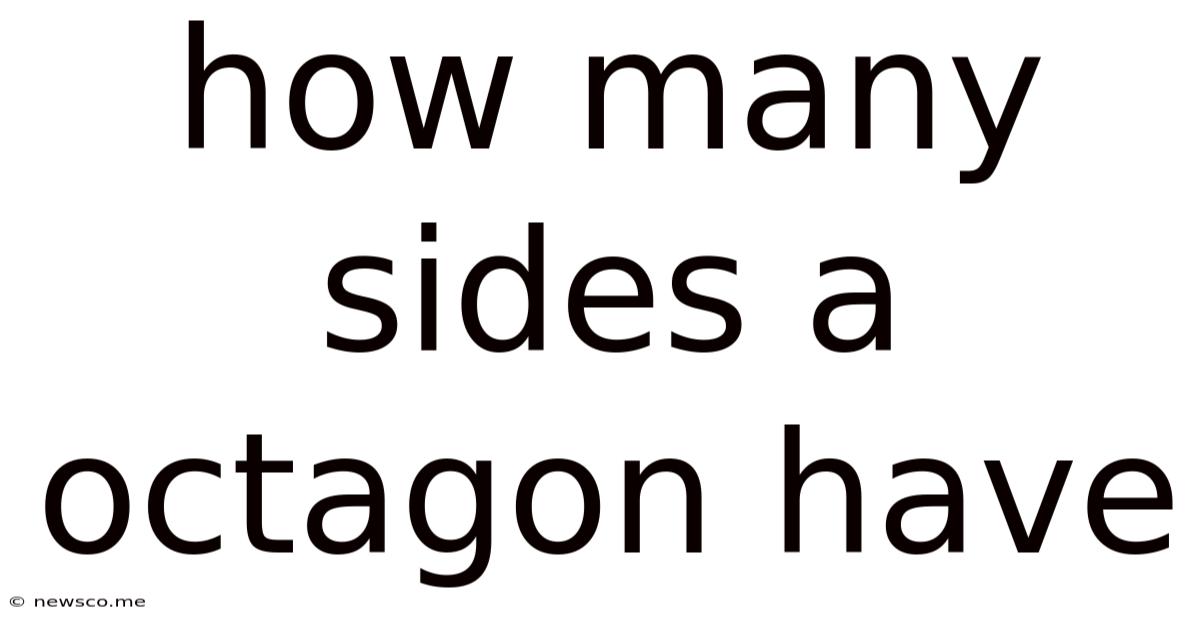How Many Sides A Octagon Have
News Co
Apr 14, 2025 · 4 min read

Table of Contents
How Many Sides Does an Octagon Have? A Deep Dive into Octagonal Geometry
The question, "How many sides does an octagon have?" might seem trivial at first glance. The answer, of course, is eight. However, delving deeper into the geometry of octagons reveals a fascinating world of shapes, angles, and applications that extend far beyond a simple count of sides. This comprehensive guide will explore the octagon in detail, covering its properties, types, calculations, and real-world examples.
Understanding the Basics: Defining an Octagon
An octagon, in its simplest definition, is a polygon with eight sides and eight angles. Polygons are closed, two-dimensional shapes formed by straight line segments. Octagons belong to a larger family of polygons, which also includes triangles, squares, pentagons, hexagons, and many more. The prefix "octo" signifies eight, directly relating to the number of sides and angles in this particular geometric shape.
Regular vs. Irregular Octagons: A Key Distinction
Not all octagons are created equal. A crucial distinction lies between regular and irregular octagons:
-
Regular Octagon: A regular octagon has all eight sides of equal length and all eight angles of equal measure. Each interior angle measures 135 degrees, and each exterior angle measures 45 degrees. The symmetry of a regular octagon is a defining characteristic.
-
Irregular Octagon: An irregular octagon, conversely, has sides and angles of varying lengths and measures. There's no inherent symmetry in an irregular octagon, making its properties more complex to calculate.
Calculating the Properties of an Octagon
The properties of a regular octagon are easily calculable using geometric formulas. Let's explore some key calculations:
1. Interior Angles:
The sum of the interior angles of any polygon can be calculated using the formula: (n - 2) * 180°, where 'n' represents the number of sides. For an octagon (n=8):
(8 - 2) * 180° = 6 * 180° = 1080°
Therefore, the sum of the interior angles of an octagon is 1080°. In a regular octagon, each interior angle measures 1080° / 8 = 135°.
2. Exterior Angles:
The sum of the exterior angles of any polygon, regardless of whether it's regular or irregular, always equals 360°. In a regular octagon, each exterior angle measures 360° / 8 = 45°.
3. Area of a Regular Octagon:
Calculating the area of a regular octagon requires knowing the length of its side ('a'). The formula is:
Area = 2(1 + √2) * a²
This formula allows for the precise calculation of the area given the side length.
4. Apothem and Radius:
The apothem is the distance from the center of a regular polygon to the midpoint of any side. The radius is the distance from the center to any vertex. These values are crucial in various area and perimeter calculations. For a regular octagon, the relationships between the apothem (r), radius (R), and side length (a) are:
- Apothem (r): r = a * (1 + √2) / 2
- Radius (R): R = a / (2sin(22.5°))
Understanding these formulas is essential for various octagon-related calculations.
Octagons in the Real World: Applications and Examples
Octagons are surprisingly common in various aspects of our lives, often appearing in both natural and man-made structures:
1. Architecture and Design:
- Octagonal Buildings: Many buildings incorporate octagonal designs, offering unique architectural features and maximizing space utilization.
- Stop Signs: The classic stop sign is a familiar example of a regular octagon, chosen for its easily recognizable shape.
- Tiles and Mosaics: Octagonal tiles are frequently used in flooring and wall designs, creating visually appealing patterns.
2. Nature:
While not as prevalent as other shapes in nature, octagonal structures can sometimes be observed in certain crystal formations and other natural occurrences.
3. Engineering:
Octagonal shapes can appear in various engineering applications, often chosen for their structural properties or aesthetic appeal.
4. Games and Puzzles:
Octagonal shapes are sometimes incorporated into board games and puzzles, adding a unique geometric element.
Exploring Advanced Octagon Geometry: Beyond the Basics
Beyond the fundamental properties, a deeper understanding of octagons can involve:
-
Tessellations: Investigating whether octagons can form tessellations (tilings that cover a surface without gaps or overlaps). While regular octagons alone cannot tessellate, combinations with other polygons can achieve this.
-
Star Octagons: Exploring star octagons, which are formed by extending the sides of a regular octagon to create an intersecting star shape.
-
Constructions: Examining the methods for constructing regular octagons using compasses and straightedges.
-
Three-dimensional Octagons: Exploring the concept of octagonal prisms and other three-dimensional shapes based on octagonal bases.
Conclusion: The multifaceted World of Octagons
The seemingly simple question, "How many sides does an octagon have?" opens the door to a rich and diverse exploration of geometry. From the fundamental properties of regular and irregular octagons to their surprising applications in architecture, design, and even nature, the octagon reveals a fascinating world of shapes, angles, and calculations. Whether you're a student of geometry, an architect, or simply someone curious about shapes, understanding the octagon provides valuable insights into the beauty and complexity of the mathematical world. This deep dive has only scratched the surface of the extensive mathematical concepts connected to the octagon, leaving ample opportunity for further investigation and discovery. The enduring appeal of octagons lies in their combination of simplicity and sophistication, a testament to the elegance found within geometric forms.
Latest Posts
Related Post
Thank you for visiting our website which covers about How Many Sides A Octagon Have . We hope the information provided has been useful to you. Feel free to contact us if you have any questions or need further assistance. See you next time and don't miss to bookmark.